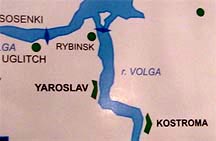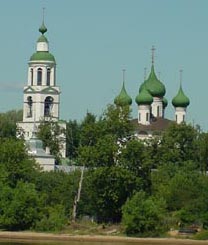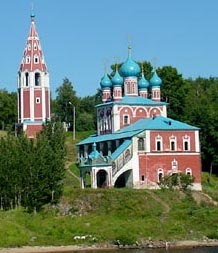Looking out our window first thing this morning, we found we were arriving at Yaroslavl. Founded in 1010, is the oldest city on the Volga River. Over the years Yaroslavl has been fairly prosperous as a major mercantile center on the Volga, resulting in the construction of numerous immaculate churches and the Grand Savior’s Monastery which is still the spiritual and cultural centre of the city.
Soon after we arrived the locals had their craft tables in place and after a brief viewing we climbed aboard buses for a tour of the city. After a tour of tne Grand Savior's Monastery we visited the city's impressive puppet theatre where there was a display of the finer work, by local artisans.
Our tour included a concert by the folk ensemble Skomoroshina. Leaving the theatre we passed through the former club room for the Russian army (Think Legion Hall) where we were offered samples of Russian vodka. But it was now time to get back to ship to be ready for a 2 p.m. departure.
Soon after leaving Yaroslavl we passed one of the newly active convents of Russia - the nearly 700-year-old Tolga Convent. A leisurely afternoon was spent enjoying the life of the river.


The monastery was closed by the Bolsheviks in 1926 and subsequently turned into a "labor education colony." In 1988 the monastery was given back to the Orthodox Church, which restored it and turned it into the Tolga Convent.

Upon leaving the lock the statue of Mother Volga was seen from the port-side of the ship. The statue marks our entrance into the Rybinsk reservoir. Now, guess what we saw as travelled the Rybinsk Reservoir?
We were travelling this reservoir at night which probably wasn't a bad thing as Russia by River explains: Sometimes called the Rybinsk Sea because of its large size, In actuality this is a, massive flood basin covering the natural beds of many different rivers, including the Volga and Sheksna. The flooding of the basin in 1941 was largely kept under wraps because of the mass destruction, human displacement, and ecological damage it necessitated. There is not much to point out sightwise, except for what you are sailing over. For example, at the southern end, where a large church and belfry stand on the western shore, the ship cruises over the point where the Volga used to meet the Mologa River at the ancient city of Mologa. Founded back in the 12th century, Mologa was a colorful regional center known ever since the 16th century for its lively annual trade fair. At the time of its flooding, it was a declining town of stone and wooden dwellings, many churches, a monastery, and a population of 7,000 people.
So inside we went for (the dreaded) costume night. It started at dinner and ended with a costume show. Those crazy enough to participate (including me) received champagne for their effort.
